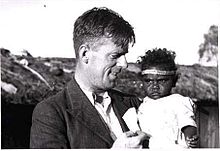- Norman Tindale
-
Norman Barnett Tindale (12 October 1900 – 19 November 1993) was an Australian anthropologist, archaeologist and entomologist. Born in Perth, his family moved to Tokyo from 1907 to 1915, where his father worked as an accountant at the Salvation Army mission in Japan. Soon after returning to Australia, Tindale got a job at the South Australian Museum in Adelaide. Tindale was an assistant to Arthur Mills Lea.[1]
Shortly after this, Tindale lost the sight in one eye in an explosion which occurred during photographic processing. This disability hindered him from following his boyhood passion for entomology, but he was still able to do important work, especially with hepialid moths.
Tindale is best remembered for his work mapping the various tribal groupings of Indigenous Australians. This interest began with a research trip to Groote Eylandt where an Anindilyakwa man gave Tindale very detailed descriptions of which land was his and which land was not. This led Tindale to question the official orthodoxy of the time which was that Aborigines were purely nomadic and had no connection to any specific region. While Tindale's methodology and his notion of the dialectal tribe have been superseded, this basic premise has been proved correct.
After his retirement from the South Australian Museum, Tindale took up a teaching position at the University of Colorado and remained in the United States until his death, aged 93, in Palo Alto, California. [2]
At the University of Adelaide, he had a 50-year collaboration with Joseph B Birdsell of Harvard University and performed an anthropological survey in 1938-39 and 1952-54 on Aboriginal missions across Australia.
References
- ^ E. G. Matthews, 'Lea, Arthur Mills (1868 - 1932)', Australian Dictionary of Biography, Volume 10, MUP, 1986, pp 31-32. Retrieved on 2009-07-17
- ^ Norman B Tindale obituary, http://www.anu.edu.au/linguistics/nash/aust/nbt/obituary.html
External links
- Online Guide to Records at the South Australian Museum Archives
- Tindale Biography at South Australian Museum
- Tindale's Catalogue of Australian Aboriginal Tribes online at the South Australian Museum
- Tindale bibliography

This biographical article about an archaeologist is a stub. You can help Wikipedia by expanding it. This article about an entomologist is a stub. You can help Wikipedia by expanding it.

